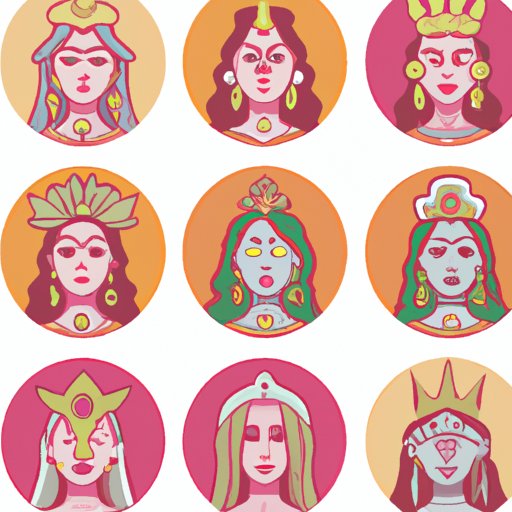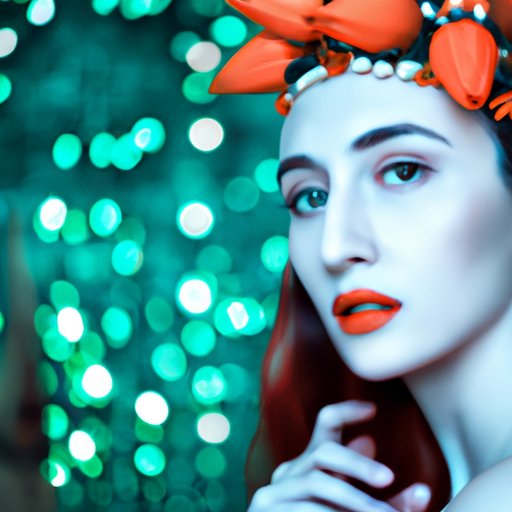
Introduction
Beauty has always held a special place in human cultures. In different mythologies, the gods and goddesses were frequently depicted as radiant, beautiful beings, representing grace, perfection, and harmony. Beauty was often associated with power and divinity, and the pursuit of beauty was considered a spiritual and moral obligation. Many cultures had their own goddesses of beauty, revered and worshiped as symbols of purity, fertility, and creativity. However, identifying the goddess of beauty can be challenging, as different mythologies have their unique narratives and interpretations. In this article, we will delve into the myths and legends of six goddesses of beauty from various mythologies, exploring their origin stories, symbols, and cultural significance.

Exploring the Myths and Legends of Aphrodite: The Greek Goddess of Beauty
The Greek goddess Aphrodite is one of the most renowned and captivating goddesses of beauty in history. She was said to have emerged from the foam of the sea, born of Uranus’s severed genitals and dropped into the ocean by his son Cronus. From an early age, she was known for her dazzling beauty, charm, and poise, coveted by all the gods and mortals.
Aphrodite was primarily associated with love and desire, inspiring passion, sensuality, and romance wherever she went. She was one of the twelve Olympians, the principal deities of Greek mythology who resided on Mount Olympus. She had several powers and domains, including love, fertility, sexuality, and beauty.
Aphrodite was often depicted with roses, myrtle, doves, and swans, symbolizing love, passion, and purity. She had many lovers, both gods and mortals, and her beauty was considered a curse by some who envied her. Nevertheless, she remained a ubiquitous and beloved figure in Greek mythology, inspiring poets, artists, and storytellers for centuries.
The Cult of Venus: Unraveling the History and Worship of the Roman Goddess of Beauty
While Aphrodite was the Greek goddess of love and beauty, Venus was her Roman counterpart, closely associated with femininity, sexuality, and love. The Romans identified Venus with the Greek goddess Aphrodite, but over time, her image and mythology diverged, assuming a distinctive identity.
Venus was considered the ancestor of the Roman people, originating from the sky and settling in the city of Rome. She was the goddess of garden cultivation, sex, and fertility, and her cult was omnipresent in Roman society.
Venus was often depicted with her son Cupid, her beloved consort Mars, or by herself, holding a mirror or an apple, symbols of vanity and desire. Her shrines were widespread throughout the Roman Empire, and her worshippers would conduct rituals, sacrifices, and offerings to honor her. Today, her legacy lives on in cultural artifacts, such as the famous Venus de Milo statue and other works of art.
Beauty Personified: A Look into the Iconic Depictions of the Egyptian Goddess Hathor
Unlike Aphrodite and Venus, the Egyptian goddess Hathor represented more than just physical beauty. She was the goddess of love, motherhood, fertility, and divine feminine power, embodying the nurturing and life-giving aspects of womanhood.
Hathor was depicted as a cow, lioness, or woman with cow horns, adding to her majestic and robust character. She was the patron of musicians, dance, and joy, inspiring creativity and celebration. Hathor was also a protector of the dead, offering solace and guidance to the departed on their journey to the afterlife.
Hathor’s influence extended beyond Egypt, with her worship reaching many parts of the Mediterranean, including Greece and Rome. Hathor was an iconic goddess, a symbol of feminine empowerment and spiritual devotion.
From Freyja to Idun: The Norse Goddesses of Beauty and Youth
The Norse mythology had its unique set of goddesses, embodying different aspects of beauty and youth. Two of the most prominent goddesses were Freyja and Idun, goddesses of love, fertility, youth, and rejuvenation.
Freyja was said to be the most beautiful and desired goddess among all the Norse deities. She was the goddess of love, fertility, and war, seen as a leader of the Valkyries, powerful female warriors who would escort the bravest warriors to Valhalla. Her beauty and charm were legendary, but behind her grace lay a fierce and uncompromising spirit.
Idun, on the other hand, was the goddess of youth and rejuvenation. She was a guardian of the golden apples, which when eaten, granted eternal youth and vitality. Her beauty was pure and innocent, radiating grace and wonder.
Both Freyja and Idun represented different aspects of beauty and youth in Norse mythology, inspiring their followers to embrace love, life, and adventure. Despite their differences, they shared the same spiritual affinity and dedication, making them revered figures among the Norse pantheon.
Beyond Physical Looks: The Meaning and Symbolism Behind the Hindu Goddess Lakshmi
The Hindu goddess Lakshmi was not merely a goddess of beauty but also a goddess of wealth, prosperity, fortune, and luck. Her beauty was not limited to her physical appearance but emanated from her aura and inner grace.
Lakshmi was often depicted with lotus flowers, symbolizing purity, prosperity, and enlightenment. She was also associated with elephants, owls, and peacocks, representing intelligence, wisdom, and freedom. Her worship was widespread in India, with her festivals, such as Diwali, being one of the most celebrated and auspicious occasions for Hindus worldwide.
Although Lakshmi was mainly known for her association with wealth and prosperity, her beauty was also intrinsic to her identity, reminding people of the power of inner beauty and kindness. Her symbolism and philosophy have inspired people of all ages, genders, and cultures, making her one of the most influential goddesses of all time.
The Allure of Oshun: Learning about the Beauty and Power of the Yoruba Goddess
The Yoruba culture of West Africa had its unique goddess of beauty, Oshun, a goddess of love, motherhood, and rivers. She was the epitome of radiance, grace, and sensuality.
Oshun was often depicted with mirrors, fans, or peacock feathers, accentuating her beauty and charisma. She was the patron of sweet waters, a symbol of fertility and purification. Her worship was prevalent in many Yoruba communities, with her festivals, such as Oshun Osara, being among the most colorful and vibrant celebrations in Nigeria.
Oshun was not only a goddess of beauty but also a goddess of power, representing feminine wisdom, creativity, and strength. Her followers would seek her guidance and blessings, hoping to harness her energy and grace. Today, she remains a beloved and influential goddess, revered by women and men alike across the globe.
The Many Manifestations of Beauty: A Comparative Study of Goddesses from Different Mythologies
As our exploration has shown, goddesses of beauty are not one-dimensional entities but multifaceted beings, embodying different aspects of beauty, love, femininity, and spirituality. While they may have their unique narratives and symbolism, they share a universal human experience – the quest for truth, grace, and purpose.
Comparing and contrasting the various goddesses of beauty can unveil similarities and differences across cultures, fostering a deeper understanding of human nature and our shared heritage. Through myths and legends, we can learn valuable lessons about the power of beauty, the significance of love, and the role of femininity in our lives.
Thus, studying the goddesses of beauty is not an idle pursuit but rather an enriching and enlightening experience that can broaden our horizons and uplift our spirits.
Conclusion
Beauty has captivated humanity since the dawn of time, manifesting itself in different forms, stories, and myths. Exploring the world of goddesses of beauty has revealed an intricate tapestry of beauty, power, and personality, showing us that our fascination with beauty goes beyond physical appearance.
By studying the myths and legends of Aphrodite, Venus, Hathor, Freyja, Idun, Lakshmi, and Oshun, we have unearthed a treasure trove of wisdom, symbolism, and cultural diversity. Each goddess represents a unique facet of beauty and humanity, inspiring us to embrace our inner grace and radiance.
The goddesses of beauty have left an indelible mark on human history, shaping our perceptions of the world and our values. They remind us that beauty is not just superficial but also a window into our souls, a reflection of our spirit and divinity.




